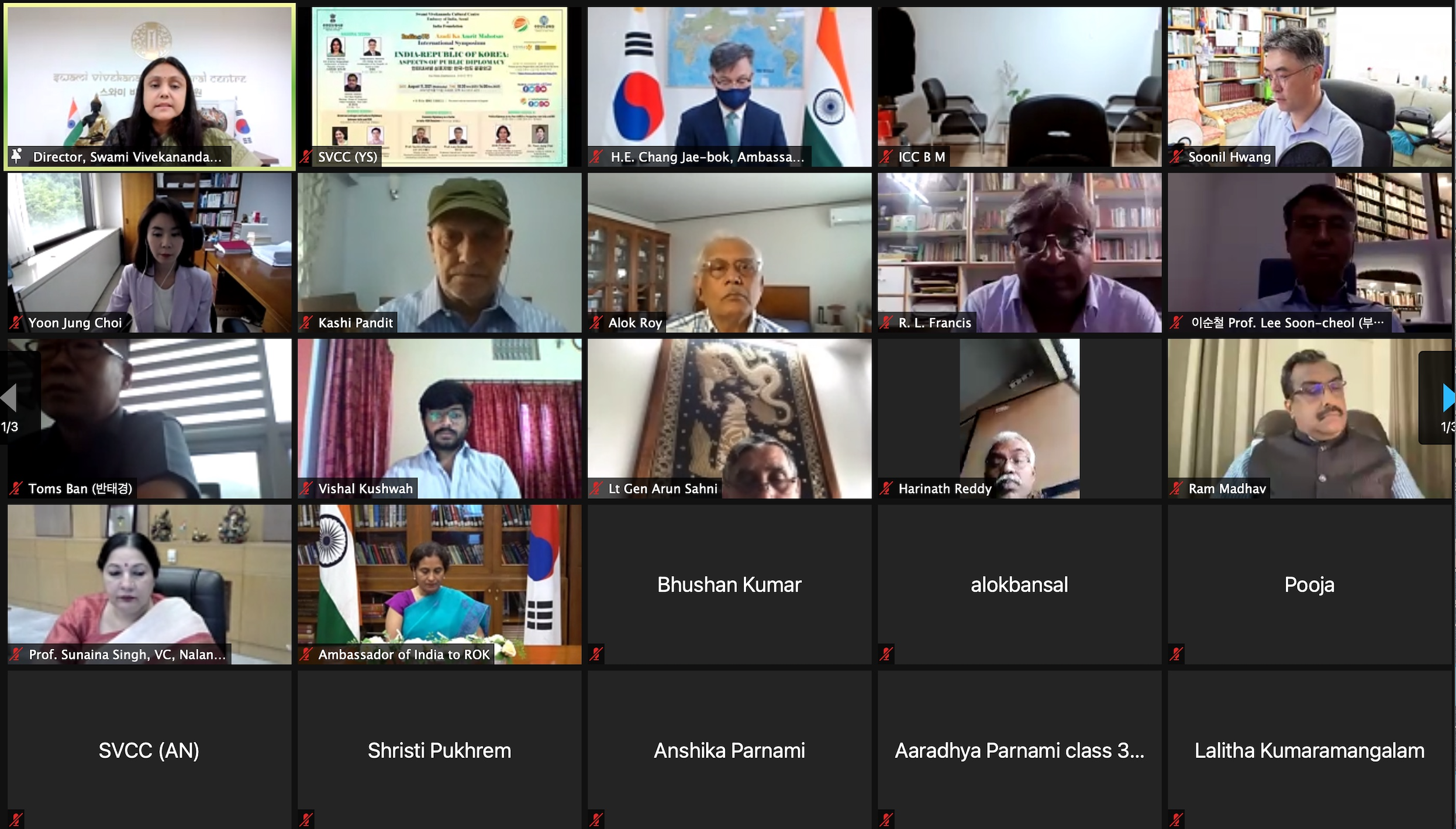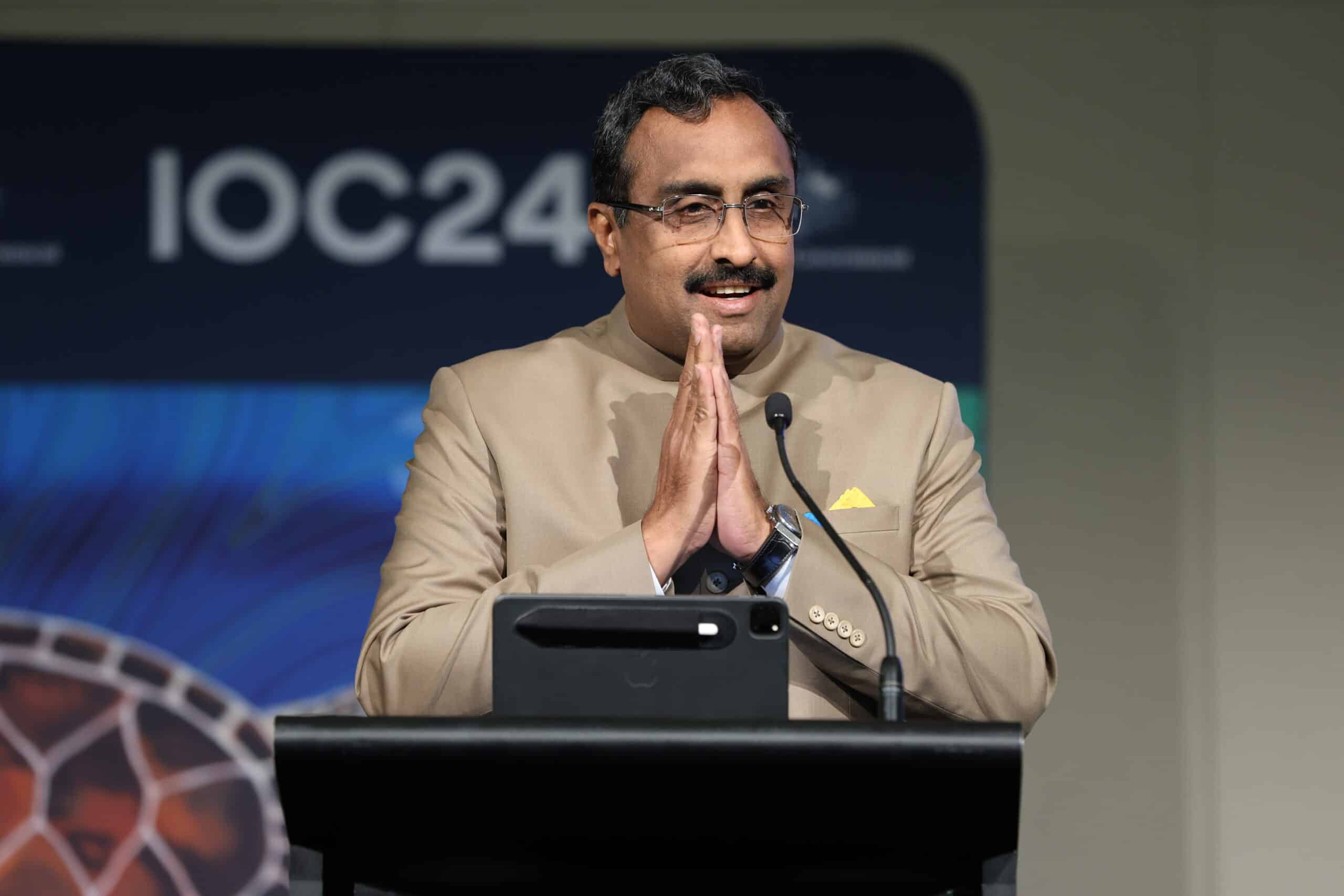
|
Getting your Trinity Audio player ready...
|
Text of Shri Ram Madhav’s Address at a webinar organised by India Foundation in collaboration with Swami Vivekananda Cultural Centre, Embassy of India in Seoul; Department of Indian Studies, Busan University of Foreign Studies; and College of Buddhism, Dongguk University, Seoul on “India-Republic of Korea: Aspects of Public Diplomacy” on August 11, 2021
India’s proactive Ambassador in Seoul, Amb. Supriya Ranganathan, Ambassador of the Republic of Korea in Delhi Amb. Chang Jae-bok, and dear friends!
Let me at the very outset congratulate the dynamic Director of Swami Vivekananda Cultural Centre, Embassy of India, Seoul Dr. Sonu Trivedi for putting together this important Symposium in collaboration with the India Foundation, Dongguk University and Busan University of Foreign Studies!
The significance of this symposium is that it is being hosted on the eve of the Amrit Mahotsav or Platinum Jubilee – 75th year of India’s independence, which falls on 15 August this year. India secured its independence from the British colonial regime on 15 August 1947.
The significance further enhances when we realize that Korea had also emerged as a Republic on that very day, 15 August, one year later in 1948.
Friends!
India and South Korea are today having strong bilateral ties. We have upgraded our relations to a ‘Special Strategic Partnership’ recently.
South Korea accords India a status on par with its four traditional partners on the East and West under the ‘New Asia Community Framework’.
President Moon Jae-in’s ‘New Southern Policy’ of 2017 and India’s Act East Policy have a significant point of convergence in the ASEAN and South-East Asia.
Our two countries enjoy a robust bilateral trade that exceeds $ 20 B.
Leaders of our two countries meet regularly during bilateral visits or on the sidelines of international summits.
We are two successful democracies in a region that is increasingly staring at democracy deficit and authoritarian overshadow.
In the face of the propaganda by our neighbors that democracies are inefficient and failed models, India has proved in the last seven decades that democracies can be successful and efficient.
South Korea, which became a vibrant democracy more than three decades ago showed that democracies can also give prosperity and material well-being to their people.
South Korea is today a world leader in Information and Communication Technology.
Our bilateral relationship, together with our active collaboration at the multilateral level will certainly become a defining feature for the future of the region.
Friends!
Public diplomacy is about building relationships between nations beyond politics and diplomacy.
It is essentially about people-to-people relations.
There is a great scope for improvement in this arena in case of our two countries.
Although, as fellow democracies, we enjoy great goodwill for each other, the engagement at the people level has been minimal between our two countries.
Koreans largely knew about India through Buddha, while Indians got to know about South Korea through Gangnam style.
In fact, not just our present and future, but even our respective pasts have several commonalities that can help build greater understanding between our two societies.
Both our nations are ancient in origin. The known history of the Koreans dates back beyond 8000 BCE.
India too is an ancient nation with millennia-old history.
In the long history of our civilizations, paths of our two societies have crossed at the intersection of Buddhism.
Korean Buddhist Monk Hyecho (704–787 CE) or Hong Jiao visited India from 723 to 729 AD and wrote the travelogue – “Pilgrimage to the five kingdoms of India” – which gives a vivid contemporary account of Indian culture, politics and society.
But we are also related by blood historically through the Princess of Ayodhya, Suriratna, who, according to the 13thcentury historical work “SamgukYusa” or “The Heritage History of the Three Kingdoms”, married King Kim-Suro, and became Queen Heo Hwang-ok in the year 48 AD.
Incidentally, many leaders of South Korea like former Presidents Kim Dae-jung and Kim Young-sam, and former PM Kim Jong-pil trace their ancestry to the royal couple.
Friends!
Since we are meeting on the occasion of India’s 75thindependence day, it may be worthwhile to mention that our two countries have several common features when it comes to the struggle for independence too.
It is both fascinating and painful to read the history of our respective independence movements.
We were both victims of colonialism for centuries – India from the Turks, Mughals and the British and Korea from the Chinese, Russians and the Japanese.
The March 1 Movement, launched in 1919 to free Korea from the Japanese occupation coincides with India’s Non-Cooperation Movement, which was also launched in 1919 to oust the British colonists.
Incidentally both were peaceful movements for freedom.
Our two countries had fallen victim to the colonial machinations and ended up partitioned at the time of our independence.
Both are suffering the evil consequences of it even to this day.
I won’t go into the details but can’t resist the temptation to mention that had Gen Douglas McArthur, the US Army general overseeing Korean independence, prevailed, not the then US President Dwight Eisenhower, there would not have been a 38thParallel dividing the Koreans.
McArthur was not in favour of halting the US Forces at the dividing line. He had to be removed as the General before Eisenhower and the UN could go ahead with the partition plan.
Remember Stalin died few months before the imposed partition of Korea in July 1953.
Similarly, had the Indian leadership prevailed, not Lord Mountbatten, India too wouldn’t have been partitioned in 1947.
Remember the Father of Pakistan, Md Ali Jinnah died in September 1948 just over a year after the partition.
If history has ifs and buts, we two countries would perhaps have opted for a different transition at the time of our independence.
Friends!
India played an important role in establishing peace and order in the Korean Peninsula after the independence in 1945 and during the Korean War of 1950-53.
Mr K P S Menon of India was the Chairman of the 9-member UN Commission set up in 1947 to hold elections in Korea.
During the Korean War (1950- 53), both sides accepted a resolution sponsored by India, and the ceasefire was declared on 27 July 1953.
Lt. General K.S. Thimayya of India, served as the chairman of the Neutral Nations Repatriation Commission [NNRC] after the armistice and contributed to resolving the humanitarian issues arising out of the War, and won appreciation from all quarters.
Friends!
Let me conclude by saying that beyond what is known, people of our two nations have many more things in common in our history, many things to learn and unlearn from each other’s experience and many great ideals of our religions and cultures to cherish and share.
Let us engage more through the platforms of public diplomacy like this one to pursue that endeavour for the benefit not only of our two peoples, but the entire humanity.
Thank you.



